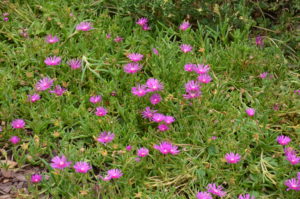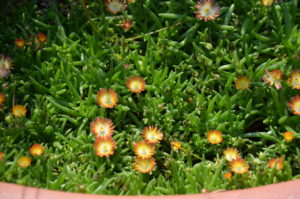Ice plants (Delosperma spp.) are perennial evergreen succulents from South Africa. Two species are most popular in U.S. gardens starting with hardy ice plant (D. cooperi) (zones 6b – 9) and yellow ice plant (D. nubigenum) (zone 4 – 10). There are also many hybrid cultivars sold at garden centers and on-line.
North of zone 7, hardy ice plants (D. cooperi) are semi-evergreen and needs winter protection. This succulent mat-forming plant typically grows to 3 – 6 inches tall and spreads quickly to 24 or more inches in width. High gloss, bright red-purple, daisy-like flowers (up to 2 inches or 5 cm across) cover the plant from June to September. Bloom colors are iridescent. The succulent foliage is generally medium green.
Yellow ice plants (D. nubigenum) form a low mat of succulent, evergreen leaves, bearing loads of small starry yellow flowers starting in late spring. Plants grow 2 – 4 inches tall, and form a tight attractive mat. Foliage take on vibrant pinkish tint over winter.
Ice plants are best grown in dry, sharply-drained soils in full sun. Plants fail (die) in almost any kind of soil that is not adequately drained. Sandy and gravelly soils are the best. Ice plants are especially responsive in reduce reflected heat and glare when planted in areas covered with gravel mulch. Plants are exceptionally heat and drought tolerant. Feed only once annually with a very dilute fertilizer solution and water sparingly.
Ice plants are trouble free with regard to insect or disease problems. Aphids and mealybugs are occasional pests.
Garden uses: Ice plants grow well in containers or in the garden in a sunny area including rock gardens, rock walls, border fronts as edging or on slopes.
Depending on species and cultivars, plant and flower size varies; dwarf selections hug the ground. Here are four recommended selections from Plant Selects™:
Red Mountain® – large flowered blazing orange-red color and attractive growing habit (zones 4-9).
Starburst® – (D. floribundum) produces bright pink shimmering flowers with white centers (zone 5-9).
Mesa Verde® – (D. cooperi) short growing salmon-pink-flowers (zones 4-9).
Lavender Ice® – iridescent lavender blooms with dark eye; foliage turns purplish in winter (zones 4-9).



 Posted in
Posted in 

Hugh,
I enjoy your site, the information is always useful and timely.
I have a nice mat of iceplant growing – Lavender Ice cultivar. Every summer, right around now, it has an area of sudden die-off. By the end of fall the dead spot is covered back over again with new growth.
It doesn’t show any visible warning signs, like mildew or spots. Further, I don’t believe it’s drought related, given the leaves continue to look quite plump/succulent.
Any guesses what might be causing this, or is this typical of ice plant?
Thanks, Jason